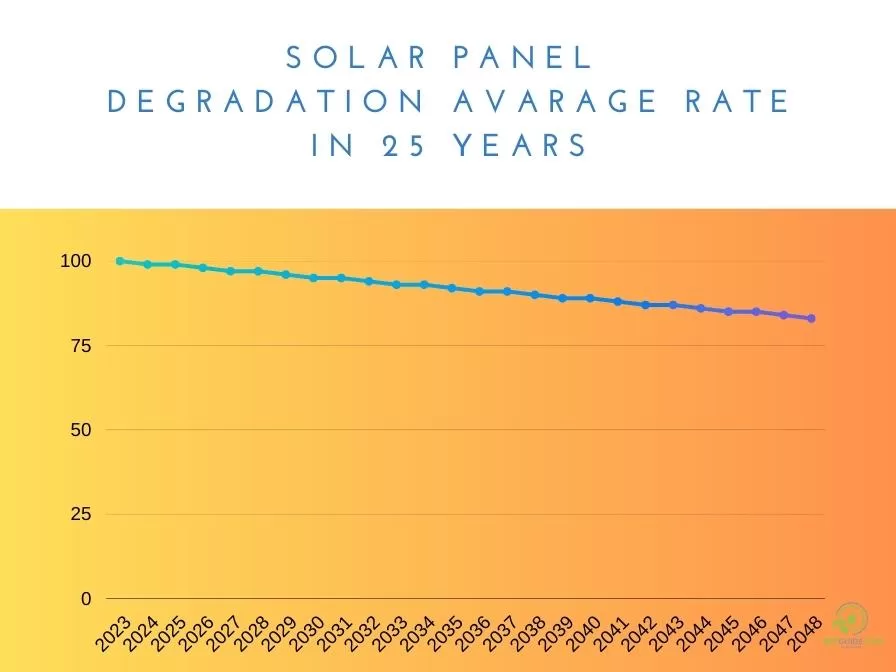Solar panels are an incredible source of clean, renewable energy, but like all technologies, they are subject to wear and tear. Over time, solar panels lose efficiency, producing less power than when they were new. This phenomenon, called solar panel degradation rate, affects solar panels over time. We’ll investigate the causes of solar panel degradation rate, and address the question of why do solar panels degrade. We’ll study measurement methods and typical degradation rates. Finally, we’ll discuss how to reduce its impact on solar panel performance.

Causes of Solar Panel Degradation
There are several factors that contribute to solar panel degradation, which can be classified into two categories: intrinsic and extrinsic factors.
Intrinsic Factors
Intrinsic factors are inherent to the solar panel’s design and materials. For example, solar cells made from silicon suffer from light-induced degradation (LID) and potential-induced degradation (PID), which cause a reduction in power output over time.
Extrinsic Factors
Extrinsic factors are external influences that can impact a solar panel’s performance. These include weather-related factors such as temperature fluctuations, humidity, and UV exposure, as well as mechanical stress from wind or snow loads.
Measuring Solar Panel Degradation
There are two primary methods for measuring solar panel degradation: power output measurement and visual inspections.
Power Output Measurement
The most common way to assess degradation is by measuring the power output of a solar panel and comparing it to its original performance. This is typically done using specialized testing equipment under standardized test conditions, ensuring accurate and consistent results.
Visual Inspections
In some cases, visual inspections can provide valuable information about a solar panel’s health. Signs of degradation, such as yellowing, delamination, or micro-cracks, can indicate that a panel’s performance is declining.
Typical Degradation Rates
Solar panel degradation rates vary depending on the type of panel and the quality of its materials and construction.
Monocrystalline Solar Panels
Monocrystalline solar panels, which are made from high-quality single-crystal silicon, typically have a degradation rate of around 0.2% to 0.5% per year.
Polycrystalline Solar Panels
Polycrystalline solar panels, composed of multiple silicon crystals, generally have a slightly higher degradation rate of about 0.3% to 0.8% per year.
Thin-Film Solar Panels
Thin-film solar panels, which use a thin layer of photovoltaic material on a substrate, usually experience higher degradation rates of around 0.5% to 1.0% per year. However, it’s important to note that degradation rates can vary widely among different manufacturers and models.
Factors Affecting Degradation Rates
Several factors can influence the degradation rate of solar panels, including:
Installation Quality
Poor installation practices can contribute to increased degradation rates by causing mechanical stress, improper ventilation, or insufficient protection from the elements.
Climate and Environmental Factors
Extreme temperature fluctuations, high humidity, and exposure to UV radiation can accelerate the degradation process. Additionally, panels installed in areas with high levels of air pollution may experience increased corrosion or soiling.
Maintenance and Cleaning
Lack of proper maintenance and cleaning can lead to dirt, dust, and debris accumulation on the panel surface, reducing its efficiency and contributing to degradation.
Mitigating Solar Panel Degradation
While solar panel degradation is inevitable, there are steps you can take to minimize its impact:
Proper Installation
Ensuring your solar panels are installed correctly by a reputable company can help prevent issues that could lead to increased degradation.
Regular Maintenance and Inspection
Routine maintenance, including cleaning and visual inspections, can help identify and address potential issues before they become significant problems. Annual professional inspections can also be beneficial in assessing the overall health of your solar system.
Conclusion
Solar panel degradation is a natural process that affects the efficiency and performance of your solar system over time. Understanding the causes and factors affecting degradation rates can help you make informed decisions about solar panel selection, installation, and maintenance. By taking proactive steps to mitigate degradation, you can maximize the lifespan and performance of your solar energy system.
Frequently Asked Questions
How long do solar panels last?
Solar panels typically last 25 to 30 years, although their efficiency will decrease gradually over time due to degradation.
Is solar panel degradation covered under warranty?
Most solar panel manufacturers offer performance warranties that guarantee a certain level of power output after a specific period, usually 25 years. If your panels’ performance falls below the guaranteed level, the manufacturer may repair or replace the affected panels.
Can solar panel degradation be reversed?
While some forms of degradation, such as soiling or corrosion, can be addressed through cleaning or maintenance, intrinsic factors like LID and PID are irreversible.
Do all solar panels degrade at the same rate?
No, degradation rates vary depending on the type of solar panel, its materials, construction, and external factors such as installation quality and environmental conditions.
Is it worth replacing degraded solar panels?
It depends on the extent of degradation and the cost of replacement. If your solar panels are still producing a significant amount of power, it may not be cost-effective to replace them. However, if the efficiency has dropped considerably, investing in new panels could lead to long-term energy savings.